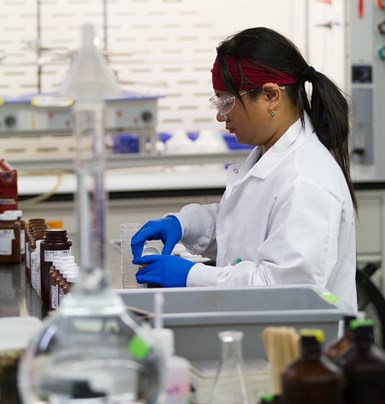Pace Offers PFAS Test Method for Contamination Detection
The PFAS contamination testing method provides reliable results faster and a lower cost.

Photo Credit: Pace Analytical Services
Pace Analytical Services, a provider of regulatory testing and analytical laboratory services, has made the PFAS Test Method ASTM D8421/EPA 8327 available to the public. The test method applies to aqueous and solid sample material.
ASTM D8421/EPA 8327 uses isotope dilution and liquid chromatography tandem mass spectrometry (LC/MS/MS) to analyze for as many as 44 PFAS compounds in both aqueous and solid sample material. The test method offers a number of advantages over other PFAS test methods, Pace says. The test requires only a 5 mL sample, helping to reduce waste, and the results can be delivered faster and at a lower price. The result of isotope dilution calibration and quantification is greater reliability of results. In addition, the method offers method detection limits (MDLs) that meet the EPA’s proposed drinking water standards and regional screening levels (RSLs).
“With the increasing focus on PFAS contamination of our environment, Pace is seeing greater demand than ever for reliable, fast testing services for complex matrices, including soil, ground and surface water, landfill leachate and more,” says Paul Jackson, Pace program manager, environmental compliance and emerging contaminants. “We are excited to be able to offer customers the ability to get results faster for important decision-making and/or to comply with increasing regulatory requirements.”
Pace is able to cite method ASTM D8421 or EPA 8327 because of the similarities of the methods. The company combined the two into the same service offering and, therefore, can cite either method depending on a customer’s regulatory jurisdiction and data quality objectives.
Related Content
-
Multi-Functional Coating Test Instruments Operate Like “Swiss Army Knives”
With greater flexibility than limited traditional equipment, modern analytical instruments can ensure reliable coating performance by measuring critical characteristics like friction, peel, wear, and scratch resistance.
-
Mastering Uniformity Through Surface Prep Standardization
By standardizing surface preparation processes and adopting surface energy measurement, a company can achieve uniformity, quality and cost reduction.
-
NASF/AESF Foundation Research Project #121: Development of a Sustainability Metrics System and a Technical Solution Method for Sustainable Metal Finishing - 12th Quarterly Report
This NASF-AESF Foundation research project report covers the twelfth quarter of project work (January-March 2023) at Wayne State University in Detroit. In this period, our main effort concentrated on documenting technical content that was yet to be reported, including analysis of costs for specific technologies for sustainability improvement.









.jpg;maxWidth=300;quality=90)


